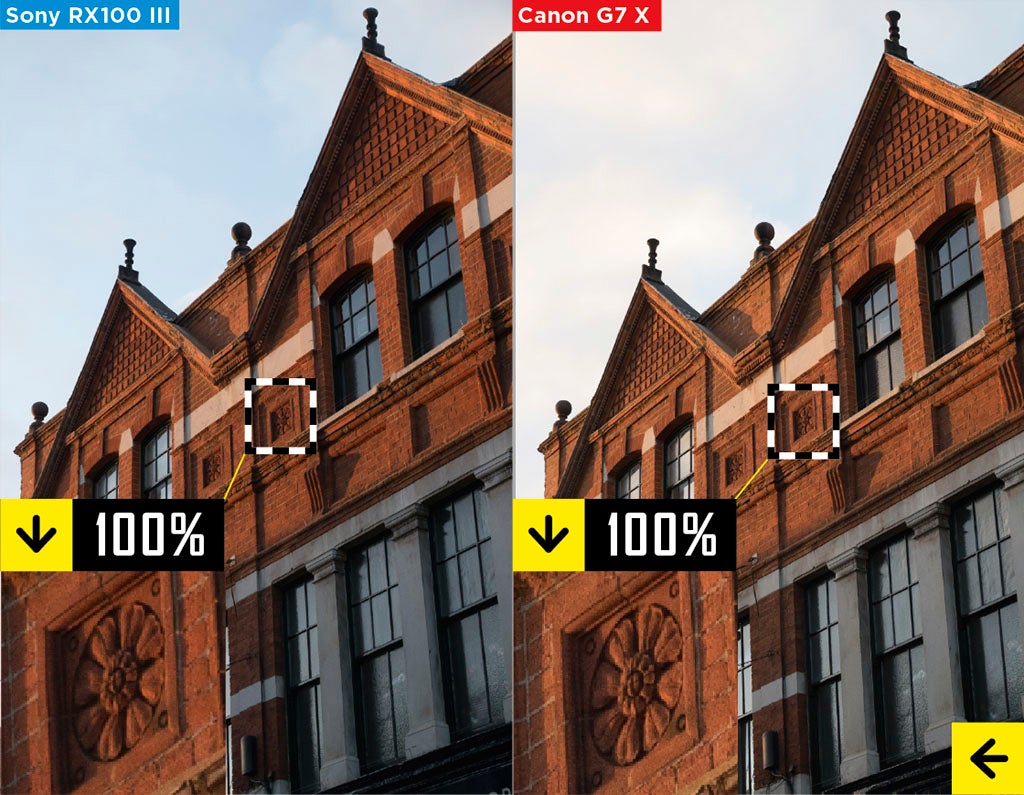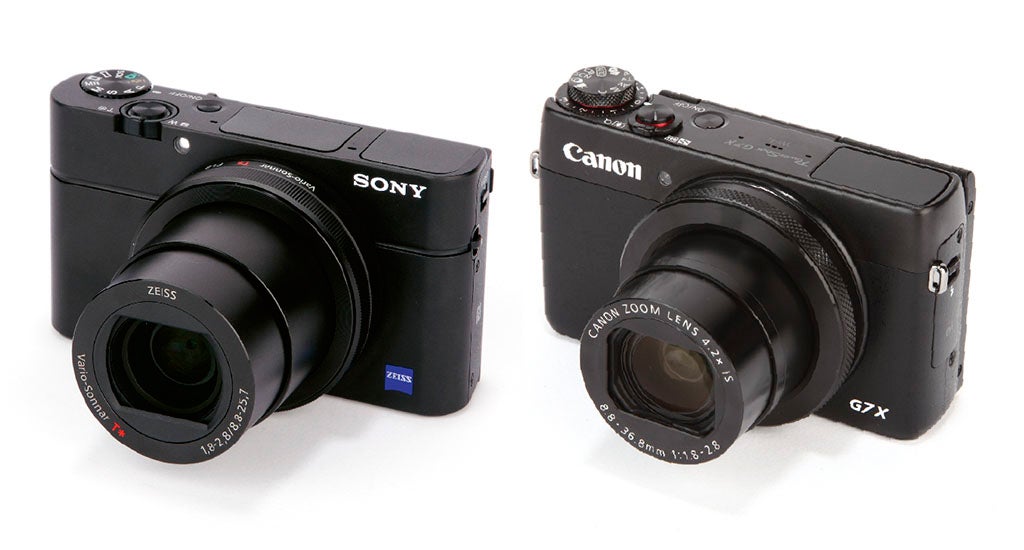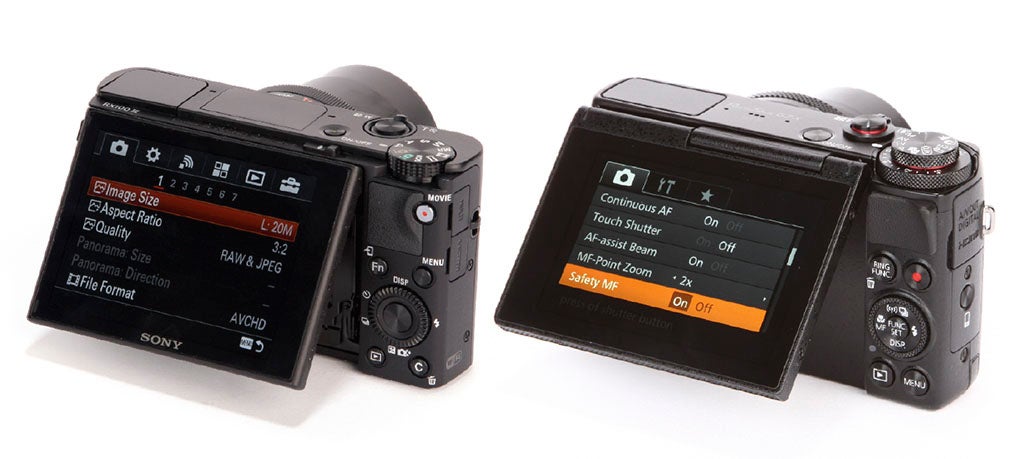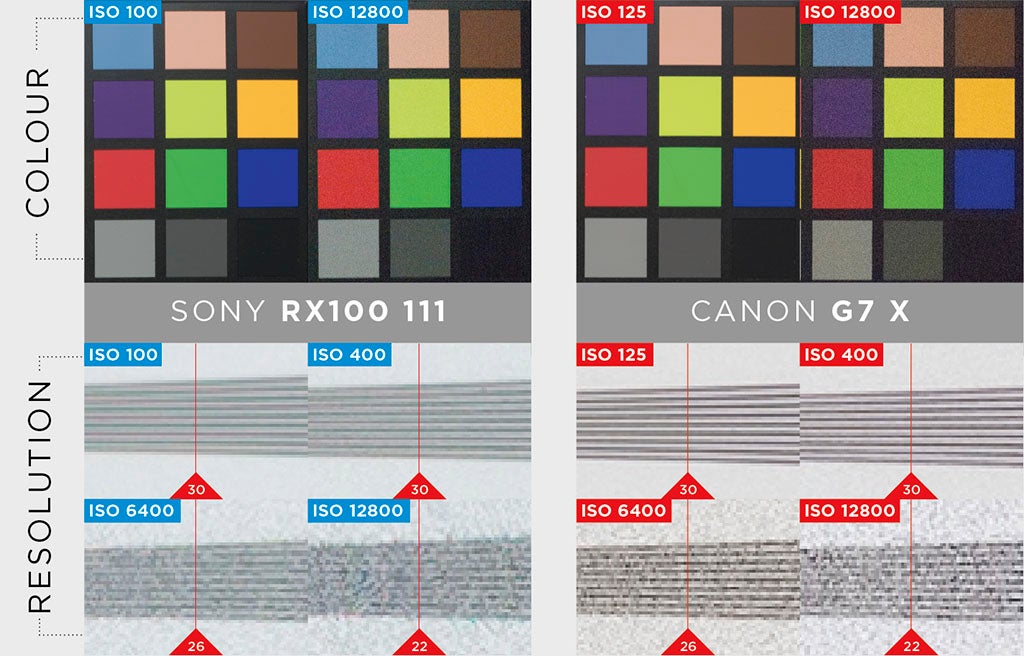Has the Sony RX100 III finally met its match? Here it fights for its place as the ultimate compact in the market against its closest new rival – the Canon PowerShot G7X
 Up until lately, Sony has dominated the premium compact area of the market with its series of RX100 cameras that squeeze a large 1in sensor inside a relatively slim body. The success of the RX100 has seen it pick up numerous accolades and it has become one of the best choices for those after a practical camera capable of producing excellent image quality, whilst being light, portable and a perfect fit for any pocket.
Up until lately, Sony has dominated the premium compact area of the market with its series of RX100 cameras that squeeze a large 1in sensor inside a relatively slim body. The success of the RX100 has seen it pick up numerous accolades and it has become one of the best choices for those after a practical camera capable of producing excellent image quality, whilst being light, portable and a perfect fit for any pocket.
Two years on from the arrival of the original RX100, other manufacturers are launching their own premium compacts with large sensors to challenge the latest from Sony in the form of the RX100 III. The Canon PowerShot G7 X also boasts a 1in sensor, but comes with its own set of features and arrives with a price that makes it stand out from the competition.
What we have here then are two very similar models, each fighting it out to be the best compact in your pocket. Can Sony’s RX100 III hold onto the title of being the ultimate premium pocket compact, or has Canon mounted the podium and taken the top spot?
Sony RX100 III vs Canon G7 X – Introduction
Looking at the sensors first, both are the same physical dimension (13.2×8.8mm) and are the back-illuminated CMOS type. Whereas the RX100 III delivers a 20.1MP effective resolution, the G7 X’s is down at 20.2MP. Both models record in the 3:2 aspect ratio and are capable of a maximum output of 5472×3648 pixels, while the processor and sensor combination on each facilitates a practical ISO range of 125-12,800. No major difference here in terms of sensor size or resolution then, but the RX100 III is the faster performer on paper, capable of shooting a continuous burst at a healthy 10fps compared the RX100 III’s slower 6.5fps.
What lies ahead of these camera’s sensors is key to their performance. Though the cameras’ lenses share the same variable aperture (f/1.8-2.8), it’s the G7 X that allows you to get closer to the action than the RX100 III. In 35mm equivalent terms, the 24-100mm focal length the G7 X offers presents greater scope over the RX100 III’s 24-70mm range, though it should be noted both zooms begin to close to f/2 virtually as soon as the zooms are operated.
So far the G7 X looks to be pulling ahead, but the RX100 III has one or two features up its sleeve. One of these is its electronic viewfinder. This pops up from the corner of the top plate and provides an alternative way to framing up a shot in extremely harsh lighting conditions.
Though its 1.44 million-dot resolution isn’t class leading, having the option to raise the camera up to your eye is a perk the G7 X doesn’t offer. That said, the 3in, 1040k-dot display theG7 X relies on for compositional purposes has the advantage of being a touchscreen, opening up the opportunity to touch focus and navigate the menu more intuitively – something that can’t be done on the RX100 III’s 1,228k-dot screen. On the subject of displays, both screens are the vari-angle type. The key difference here is that the RX100 III’s hinge is at the bottom rather than at the top, which means it has better manoeuvrability when you’d like to hold it up and shoot from above.
As to be expected, both support Raw capture as well as JPEG and there is a pop-up flash on both – the G7 X’s being the marginally larger. Touching on the contrast-detect AF systems, the G7 X presents 31 AF points next to the RX100 II’s 25, with both offering similar coverage.
As for exposure control, the maximum shutter speed range of 1/2000sec is identical on both. The RX100 III can shoot as slow as 30secs with an option to shoot in bulb mode for longer exposures. The G7 X can shoot as slow as 250secs, but no bulb mode is present. There’s no difference in terms of exposure compensation – each camera provides up to +3/-3EV control in 1/3EV steps.
Sony RX100 III vs Canon G7 X – Video
Given that both cameras capture Full HD (1920×1080) video, include stereo audio and include focus peaking for manual focus, you could be forgiven for thinking there’s little difference with regard to video. The RX100 III is superior when it comes to movie recording though with a more generous selection of frame rates, including 24p for a cinematic feel. Add to this the opportunity to adjust exposure manually and to shoot 17MP 16:9 aspect stills while recording, and the RX100 III should be the first choice for serious video users out there.
Those looking at the G7 X shouldn’t be put off by its video performance – it’s more than capable of creating great movie footage, just not to quite the same standard or with the same level of manual control as the RX100 III.
Sony RX100 III vs Canon G7 X – Design
The circumference of the G7 X’s lens is larger, but the key difference here is that the G7 X’s control ring clicks as it’s rotated whereas the RX100 III’s rotates silently. Both cameras also present a very different feel when they’re picked up. The G7 X feels less likely to slip out of your hand thanks to its subtle mottled finish and pronounced thumb rest at the rear.
The RX100 III’s extremely smooth finish to the body feels as though it could slip from your grasp at any moment, which it did on test, thankfully without causing any lasting damage. The tiny buttons beside the screen don’t make it the easiest to operate either. The G7 X’s arrangement of larger buttons combined with a twin dial on the corner of the body makes for a more enjoyable operating experience. Users will want to be wary of inadvertently adjusting the exposure compensation dial though as we found it easy to knock when rotating the mode dial.
Despite battery sizes being near identical in size, it’s the RX100 III that has the better battery life. It can shoot 320 shots on a single charge as opposed to a measly 210 on the G7 X. Carrying a spare NB-13L battery (£59) for the G7 X would be advisable. The RX100 III can also be charged via USB – particularly useful if you’re stuck for mains power in a remote location, but have a rechargeable portable battery pack to hand.
Another nice touch on the RX100 III is the way the camera can be powered up and down by popping up and retracting the EVF. Both cameras’ build quality and constructions are sublime. As to be expected from a metal body, each camera has a premium, hardwearing and robust feel.
Sony RX100 III vs Canon G7 X – Performance
Both cameras’ contrast detect autofocus systems provide a spritely performance and lock onto subjects as fast as each another in good light. The G7 X did occasionally struggle to lock onto subjects with its Macro mode deployed, despite having the same minimum focusing distance (5cm) as the RX100 III at the widest end of its zoom. The RX100 III manages to acquire focus as close as 30cm from the lens at 70mm, whereas at full telephoto on the G7 X, it can focus within 40cm of a subject.
As for setting up the autofocus and refining the position of the AF point in the frame, it’s made a much more intuitive process on the G7 X thanks to its touchscreen. On the RX100 III, instead of instinctively touching the area of the image you’d like the camera to focus on, you’re reliant on entering the Focus Area setting using the Fn button, or assign this to the central button.
While using the G7 X in continuous shooting mode with a SanDisk Extreme Pro SDHC memory card, I was able to shoot an unlimited number of JPEG files at 6.5fps until the memory card filled. Switching to continuous shooting with autofocus active dropped the speed down to 4.4fps, and it’s worth baring in mind that it’s only capable of 1.2fps if you opt to shoot in the more versatile Raw format. In comparison, 10fps shooting is available on the RX100 III provided the camera is set to its Speed Priority Continuous mode. I successfully recorded 47 Extra Fine JPEGs at 10fps and discovered the burst dropped to 6fps when the file format was switched to Raw.
Images: It’s not uncommon for cameras to render colour differently and we found this to be the case with the G7 X and RX100 III. As can be seen in the examples above, the RX100 III’s Auto White Balance interprets scenes cooler than the G7 X. This remained consistent with our other test images. While some may prefer a cooler feel to their images, there will be some who’ll prefer the warmer images produced by the Canon G7 X
Holding the shutter, I managed to record an impressive 24 continuous Raw files at 6fps before the buffer interrupted proceedings. From these results, it’s the RX100 III that comes out on top as the better of the two for recording high-speed sequences, particularly if you’re keen on shooting in Raw as opposed to JPEG.
As one of the key selling points on these cameras, the way the zoom performs is very important. Against the stopwatch, the G7 X takes just 1.8secs to get from its widest focal length to full telephoto and the same time was recorded when zooming out. This was a time matched by the RX100 III. Take into account the G7 X’s zoom operates over a longer range and goes about its business with a less high-pitched operational whir and it comes out on top in this respect.
Moving on and testing the start-up times revealed the RX100 III isn’t quite as fast as its rival. Whereas the G7 X can be switched on to take a shot in 2secs, it took the RX100 III 2.7secs to complete the same task.
Turning to the rear of the cameras, and as briefly mentioned earlier, the RX100 III’s screen is better if you regularly see yourself holding the camera high above a crowd and want to see what you’re shooting.
The RX100 III’s screen displays rich colour and a touch more contrast than its rival, but I did find myself increasing the monitor brightness to +2 from its default setting. Given the touchscreen control on the G7 X and how useful it is for navigating the menu and setting up the camera, I found it the more satisfying to use over a prolonged period of use. On the subject of menu systems, the interface on the G7 X is very easy to comprehend. The same can be said for the quick menu that’s accessed via the FUNC.SET button and lists the most frequently used settings down the side of the screen. The white on grey text is less garish than the RX100 III’s interface, which could be more overwhelming at first for novices or those upgrading from a basic point and shoot compact.
Sony RX100 III vs Canon G7 X – Image Quality
Images: With both cameras’ mode dials set to Aperture Priority and an aperture of f/5.6 dialled in with the sensitivity set to ISO 125, the G7 X sets its shutter speed to 1/200sec compared to 1/160sec on the RX100 III. This minor exposure difference remained consistent throughout our other test images and simply meant the RX100 III’s images were just a touch brighter out of the camera compared to the Canon G7 X’s
Exposure and tone
After shooting and assessing our test images, we discovered there’s around a 0.3EV difference between the two in terms of exposure. The outcome of this is that the RX100 III’s images are just a touch brighter straight out of the camera.
 Colour & White Balance
Colour & White Balance
The RX100 III’s Auto White Balance system renders scenes slightly cooler than the G7 X. Both models allow the user to change the white balance manually, with compensation and white balance bracketing available.
Image Noise
Clean and noise-free images are produced at low ISO settings as to be expected. It’s not until ISO 800 is reached that the first traces of resolution colour luminance noise start appearing, but it’s by no means as severe as noise produce by smaller imaging sensors.
Shots at ISO 3200 and 6400 preserve a high level of detail, but this does drop off at ISO 12,800, which should only be used in worst case scenarios.
Resolution
The large sensors these compacts employ not only offer superior noise response, they resolve finer details in an image. When you consider they’re both capable of resolving 30l/ph at their base ISO, they’re equal in some cases to the the level of detail that can be recorded by some CSCs.
A thorough examination of our test images also revealed the RX100 III’s in-camera processing applies slightly more sharpening to its JPEGs than the G7 X. The same could be said for the contrast – the RX100 III’s JPEGs display just a touch more punch.
 Images: As to be expected from cameras that share the same sensor size and produce an identical resolution, there’s no clear winner as to which resolves the most detail. What is impressive though is just how much detail these compacts are capable of resolving. This comes with the benefit of being able to crop into images much more tightly. Add to this the opportunity of being able to print comfortably at up to A3+ size and these compacts offer great reassurance of capturing images bursting with detail
Images: As to be expected from cameras that share the same sensor size and produce an identical resolution, there’s no clear winner as to which resolves the most detail. What is impressive though is just how much detail these compacts are capable of resolving. This comes with the benefit of being able to crop into images much more tightly. Add to this the opportunity of being able to print comfortably at up to A3+ size and these compacts offer great reassurance of capturing images bursting with detail
Sony RX100 III vs Canon G7 X – Value
Being the newer of the two models, you’d half expect the G7 X to have the higher price tag, but this isn’t the case. With a launch price of £579, which has since dropped below the £500 mark, it looks a great buy when you compare it against the RX100 III, which has only dropped £40 from its original launch price of £699. At the time of writing, the best prices found for the RX100 III were £669 through WEX, or £675 through Camera World who were offering it with a leather case and Lexar 16GB 400X Pro SDHC card.
With the G7 X costing around £169 less, it’s clear that Canon’s intension has been to undercut its direct rival on price to make it one of the first choices for those after a premium compact with a budget of £500 to spend. But how has the manufacturer been able to do this and what does another £169 get you on the RX100 III that you don’t get on the G7 X? Well, it comes down to the fact the RX100 III has an EVF, which must be seen as a useful, but costly addition. This, and of course it’s not only out to compete against the G7 X, but also another new premium compact with an electronic viewfinder – the Panasonic Lumix LX100 which was being sold at the same price as the RX100 III at the time of this review.
Sony RX100 III vs Canon G7 X – Our verdict
Although there are similarities between these two models, there are a number of differences too. Most importantly, both cameras deliver impressive image quality, but it’s what else you see as a priority that’ll govern which you go for. If you’d like more reach from your zoom, a superb touchscreen that ties in extremely well with the menu system and a camera that’s genuinely enjoyable to use and carry in your pocket, the Canon G7 X is incredibly tempting for £499. The £170 you save over its rival could even go as far as paying for a city break away!
That said, the RX100 III is appealing too and should be the choice of those who want a viewfinder, a faster continuous burst, as well as the best video performance. Other perks, such as its longer battery life, USB charging and better tilting screen could be argued it’s a camera worth paying the £170 extra for.
It’s clear there are pros and cons for each model here, but if your decision comes down to price, it’s the G7 X that gets the nod. Canon has successfully created their best pocket compact and should be acknowledged for challenging the RX100 III.











